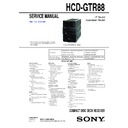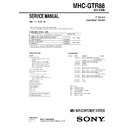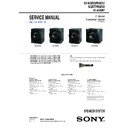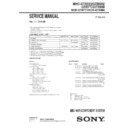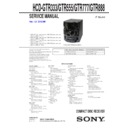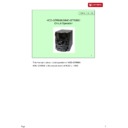Read Sony HCD-GTR88 / MHC-GTR88 Service Manual online
SERVICE MANUAL
Sony Corporation
Published by Sony EMCS (Malaysia) PG Tec
HCD-GTR88
COMPACT DISC DECK RECEIVER
9-890-544-04
2012E08-1
©
2012.05
E Model
Australian Model
Ver. 1.3 2012.05
• HCD-GTR88 is the amplifi er, USB, CD player,
tuner and tape deck (only E4 Model) section in
MHC-GTR88.
MHC-GTR88.
Photo: HCD-GTR88 (E4 Model)
CD Section
Model Name Using Similar Mechanism
HCD-GTZ4/GTZ4i/GTZ5
CD Mechanism Type
CDM88BL-DVBU101
Optical Pick-up Name
KHM-313CAB/C2NP
Tape Deck Section
(only for E4 Model)
(only for E4 Model)
Model Name Using Similar Mechanism
HCD-GT111/GT222/GT444/GT555
Tape Mechanism Type
CS-21SC-900TP
SPECIFICATIONS
Amplifi er section
The following are measured at
Mexican model:
Mexican model:
AC 127 V, 60 Hz
Other models:
AC 120 V, 220 V, 240 V, 50/60 Hz
Front/Satellite Speaker
Power Output (rated):
200 W + 200 W (at 6 Ω, 1 kHz,
1%
THD)
Front Speaker
RMS output power (reference):
345 W + 345 W (per channel at 8 Ω,
1
kHz)
Satellite Speaker
RMS output power (reference):
140 W + 140 W (per channel at 24 Ω,
1
kHz)
Subwoofer
RMS output power (reference):
200 W + 200 W (per channel at 6 Ω,
100
Hz)
Inputs
PC (AUDIO IN) L/R
Voltage 700 mV, impedance 47 kilohms
MIC
Sensitivity 1 mV, impedance 10 kilohms
(USB) port: Type A
Outputs
PHONES
PHONES
Accepts headphones of 8 Ω or more
USB section
Supported bit rate
Supported bit rate
MP3 (MPEG 1 Audio Layer-3):
32 kbps – 320 kbps, VBR
WMA: 48 kbps – 192 kbps
AAC: 48 kbps – 320 kbps
Sampling frequencies
MP3 (MPEG 1 Audio Layer-3):
32 kHz/44.1 kHz/48 kHz
WMA: 44.1 kHz
AAC: 44.1 kHz
Transfer speed
Full-Speed
Supported USB device
Full-Speed
Supported USB device
Mass Storage Class
Maximum current
500
500
mA
Disc player section
System
Compact disc and digital audio system
Laser Diode Properties
Emission Duration: Continuous
Laser Output*: Less than 44.6 μW
* This output is the value measurement
at a distance of 200 mm from the
objective lens surface on the Optical
Pick-up Block with 7 mm aperture.
objective lens surface on the Optical
Pick-up Block with 7 mm aperture.
Frequency response
20 Hz – 20 kHz
Signal-to-noise ratio
More than 90 dB
Dynamic range
More than 88 dB
Tape deck section
(For African model only)
(For African model only)
Recording system
4-track 2 channel, stereo
Tuner section
FM stereo, FM/AM superheterodyne tuner
FM tuner section
Tuning range
FM stereo, FM/AM superheterodyne tuner
FM tuner section
Tuning range
North American and Brazilian models:
87.5 MHz – 108.0 MHz (100 kHz step)
Other
models:
87.5 MHz – 108.0 MHz (50 kHz step)
Antenna
FM lead antenna
Antenna terminals
75 ohms unbalanced
Intermediate frequency
10.7
10.7
MHz
AM tuner section
Tuning range
Pan American and Oceanian models:
530 kHz – 1,710 kHz (with 10 kHz tun-
ing interval)
ing interval)
531 kHz – 1,710 kHz (with 9 kHz tuning
interval)
interval)
Other
models:
530 kHz – 1,610 kHz (with 10 kHz tun-
ing interval)
ing interval)
531 kHz – 1,602 kHz (with 9 kHz tuning
interval)
interval)
Antenna
AM loop antenna, external antenna
terminal
terminal
Intermediate frequency
450
450
kHz
General
Power requirements
Oceanian model: AC 230 V – 240 V,
50/60 Hz
Mexican model: AC 127 V, 60 Hz
Argentina model: AC 220 V, 50/60 Hz
Other models: AC 120 V, 220 V or
230 V – 240 V, 50/60 Hz, Adjustable
with voltage selector
50/60 Hz
Mexican model: AC 127 V, 60 Hz
Argentina model: AC 220 V, 50/60 Hz
Other models: AC 120 V, 220 V or
230 V – 240 V, 50/60 Hz, Adjustable
with voltage selector
Power consumption: 460 W
Dimensions (w/h/d) (excl. speakers)
(Approx.)
Dimensions (w/h/d) (excl. speakers)
(Approx.)
231 mm × 361 mm × 518 mm
Mass (excl. speakers) (Approx.)
African and Pan Asian models: 16.2 kg
Other models: 15.7 kg
Design and specifi cations are subject to
change without notice.
change without notice.
• Abbreviation
E4 : African model
HCD-GTR88
2
NOTES ON CHIP COMPONENT REPLACEMENT
• Never reuse a disconnected chip component.
• Notice that the minus side of a tantalum capacitor may be dam-
• Never reuse a disconnected chip component.
• Notice that the minus side of a tantalum capacitor may be dam-
aged by heat.
FLEXIBLE CIRCUIT BOARD REPAIRING
• Keep the temperature of soldering iron around 270 °C during repairing.
• Do not touch the soldering iron on the same conductor of the circuit
• Keep the temperature of soldering iron around 270 °C during repairing.
• Do not touch the soldering iron on the same conductor of the circuit
board (within 3 times).
• Be careful not to apply force on the conductor when soldering or unsol-
dering.
SAFETY-RELATED COMPONENT WARNING!
COMPONENTS IDENTIFIED BY MARK 0 OR DOTTED LINE
WITH MARK 0 ON THE SCHEMATIC DIAGRAMS AND IN
THE PARTS LIST ARE CRITICAL TO SAFE OPERATION.
REPLACE THESE COMPONENTS WITH SONY PARTS
WITH MARK 0 ON THE SCHEMATIC DIAGRAMS AND IN
THE PARTS LIST ARE CRITICAL TO SAFE OPERATION.
REPLACE THESE COMPONENTS WITH SONY PARTS
WHOSE PART NUMBERS APPEAR AS SHOWN IN THIS
MANUAL OR IN SUPPLEMENTS PUBLISHED BY SONY.
MANUAL OR IN SUPPLEMENTS PUBLISHED BY SONY.
CAUTION
Use of controls or adjustments or performance of procedures
other than those specifi ed herein may result in hazardous radia-
tion exposure.
Use of controls or adjustments or performance of procedures
other than those specifi ed herein may result in hazardous radia-
tion exposure.
SAFETY CHECK-OUT
After correcting the original service problem, perform the following safe-
ty check before releasing the set to the customer:
Check the antenna terminals, metal trim, “metallized” knobs, screws, and
all other exposed metal parts for AC leakage.
Check leakage as described below.
After correcting the original service problem, perform the following safe-
ty check before releasing the set to the customer:
Check the antenna terminals, metal trim, “metallized” knobs, screws, and
all other exposed metal parts for AC leakage.
Check leakage as described below.
LEAKAGE TEST
The AC leakage from any exposed metal part to earth ground and from all
exposed metal parts to any exposed metal part having a return to chassis,
must not exceed 0.5 mA (500 microamperes.). Leakage current can be
measured by any one of three methods.
1. A commercial leakage tester, such as the Simpson 229 or RCA WT-
The AC leakage from any exposed metal part to earth ground and from all
exposed metal parts to any exposed metal part having a return to chassis,
must not exceed 0.5 mA (500 microamperes.). Leakage current can be
measured by any one of three methods.
1. A commercial leakage tester, such as the Simpson 229 or RCA WT-
540A. Follow the manufacturers’ instructions to use these instru-
ments.
ments.
2. A battery-operated AC milliammeter. The Data Precision 245 digital
multimeter is suitable for this job.
3. Measuring the voltage drop across a resistor by means of a VOM or
battery-operated AC voltmeter. The “limit” indication is 0.75 V, so
analog meters must have an accurate low-voltage scale. The Simpson
250 and Sanwa SH-63Trd are examples of a passive VOM that is
suitable. Nearly all battery operated digital multimeters that have a 2
V AC range are suitable. (See Fig. A)
analog meters must have an accurate low-voltage scale. The Simpson
250 and Sanwa SH-63Trd are examples of a passive VOM that is
suitable. Nearly all battery operated digital multimeters that have a 2
V AC range are suitable. (See Fig. A)
1.5 k
Ω
0.15
μF
AC
voltmeter
(0.75 V)
voltmeter
(0.75 V)
To Exposed Metal
Parts on Set
Parts on Set
Earth Ground
Fig. A. Using an AC voltmeter to check AC leakage.
This appliance is classified as a CLASS 1
LASER product. This marking is located on
the rear exterior.
LASER product. This marking is located on
the rear exterior.
TABLE OF CONTENTS
1.
SERVICING NOTES
.............................................. 3
2. DISASSEMBLY
2-1. Disassembly
Flow
........................................................... 5
2-2. Case
(Side-L/R)
.............................................................. 6
2-3. Top
Case.......................................................................... 6
2-4. Tape Mechanism Deck (For African Model only) .......... 7
2-5. Front Panel Block, HUB Board, DMB19 Board ............ 7
2-6. DC Fan (M101) ............................................................... 8
2-7. Back Panel, SUBTRANS Board ..................................... 8
2-8. MAIN Board .................................................................. 9
2-9. DC Fan (M101), PT SHIELD Board,
2-5. Front Panel Block, HUB Board, DMB19 Board ............ 7
2-6. DC Fan (M101) ............................................................... 8
2-7. Back Panel, SUBTRANS Board ..................................... 8
2-8. MAIN Board .................................................................. 9
2-9. DC Fan (M101), PT SHIELD Board,
POWER AMP Board Section ......................................... 9
2-10. POWER AMP Board, SUBWOOFER Board ................. 10
2-11. Chassis Section ............................................................... 10
2-12. CD Mechanism Block (CDM88BL-DVBU101) ............ 11
2-13. Optical Pick-up Block (KHM-313CAB) ........................ 11
2-14. Belt (DLM3A) ................................................................ 12
2-11. Chassis Section ............................................................... 10
2-12. CD Mechanism Block (CDM88BL-DVBU101) ............ 11
2-13. Optical Pick-up Block (KHM-313CAB) ........................ 11
2-14. Belt (DLM3A) ................................................................ 12
3.
TEST MODE
............................................................. 13
4. MECHANICAL
ADJUSTMENTS
....................... 15
5. ELECTRICAL
ADJUSTMENTS
......................... 16
6. DIAGRAMS
6-1. Block Diagram - RF SERVO, USB Section - ................. 17
6-2. Block Diagram - MAIN Section - ................................... 18
6-3. Block Diagram - AMP Section - ..................................... 19
6-4. Block Diagram - DISPLAY,
6-2. Block Diagram - MAIN Section - ................................... 18
6-3. Block Diagram - AMP Section - ..................................... 19
6-4. Block Diagram - DISPLAY,
POWER SUPPLY Section - ............................................ 20
6-5. Printed Wiring Board - DISPLAY Board - ..................... 22
6-6. Schematic Diagram - DISPLAY Board - ........................ 23
6-7. Printed Wiring Board - DMB19 Board - ........................ 24
6-8. Schematic Diagram - DMB19 Board (1/3) - .................. 25
6-9. Schematic Diagram - DMB19 Board (2/3) - .................. 26
6-10. Schematic Diagram - DMB19 Board (3/3) - .................. 27
6-11. Printed Wiring Board - POWER AMP Board - .............. 28
6-12. Schematic Diagram - POWER AMP Board - ................. 29
6-13. Printed Wiring Board - MAIN Board - ........................... 30
6-14. Schematic Diagram - MAIN Board (1/3) - ..................... 31
6-15. Schematic Diagram - MAIN Board (2/3) - ..................... 32
6-16. Schematic Diagram - MAIN Board (3/3) - ..................... 33
6-17. Printed Wiring Board - MIC, VOL and USB Board - .... 34
6-18. Schematic Diagram - MIC, VOL and USB Boards - ...... 35
6-19. Printed Wiring Board - TC Board - ................................. 36
6-20. Schematic Diagram - TC Board - ................................... 36
6-21. Printed Wiring Board
6-6. Schematic Diagram - DISPLAY Board - ........................ 23
6-7. Printed Wiring Board - DMB19 Board - ........................ 24
6-8. Schematic Diagram - DMB19 Board (1/3) - .................. 25
6-9. Schematic Diagram - DMB19 Board (2/3) - .................. 26
6-10. Schematic Diagram - DMB19 Board (3/3) - .................. 27
6-11. Printed Wiring Board - POWER AMP Board - .............. 28
6-12. Schematic Diagram - POWER AMP Board - ................. 29
6-13. Printed Wiring Board - MAIN Board - ........................... 30
6-14. Schematic Diagram - MAIN Board (1/3) - ..................... 31
6-15. Schematic Diagram - MAIN Board (2/3) - ..................... 32
6-16. Schematic Diagram - MAIN Board (3/3) - ..................... 33
6-17. Printed Wiring Board - MIC, VOL and USB Board - .... 34
6-18. Schematic Diagram - MIC, VOL and USB Boards - ...... 35
6-19. Printed Wiring Board - TC Board - ................................. 36
6-20. Schematic Diagram - TC Board - ................................... 36
6-21. Printed Wiring Board
- TRANS and SUBTRANS Board - ............................... 37
6-22. Schematic Diagram
- TRANS and SUBTRANS Boards - .............................. 38
6-23. Printed Wiring Board - SUBWOOFER Board - ............. 39
6-24. Schematic Diagram - SUBWOOFER Board - ................ 40
6-25. Printed Wiring Board - HUB Board - ............................. 41
6-26. Schematic Diagram - HUB Board - ................................ 42
6-24. Schematic Diagram - SUBWOOFER Board - ................ 40
6-25. Printed Wiring Board - HUB Board - ............................. 41
6-26. Schematic Diagram - HUB Board - ................................ 42
7.
EXPLODED VIEWS
7-1. Case
Section
.................................................................... 53
7-2. Top Panel Section ........................................................... 54
7-3. Loading Panel Section, HUB Board Section,
7-3. Loading Panel Section, HUB Board Section,
DMB19 Board Section .................................................... 55
7-4. DISPLAY Board Section ............................................... 56
7-5. Front Panel Section ......................................................... 57
7-6. Back Panel Section ......................................................... 58
7-7. MAIN Board Section ..................................................... 59
7-8. Chassis
7-5. Front Panel Section ......................................................... 57
7-6. Back Panel Section ......................................................... 58
7-7. MAIN Board Section ..................................................... 59
7-8. Chassis
Section
............................................................... 60
7-9. CD Mechanism Section (CDM88BL-DVBU101) ......... 61
8.
ELECTRICAL PARTS LIST
............................... 62
HCD-GTR88
3
SECTION 1
SERVICING NOTES
NOTES ON HANDLING THE OPTICAL PICK-UP
BLOCK OR BASE UNIT
BLOCK OR BASE UNIT
The laser diode in the optical pick-up block may suffer electro-
static break-down because of the potential difference generated by
the charged electrostatic load, etc. on clothing and the human body.
During repair, pay attention to electrostatic break-down and also
use the procedure in the printed matter which is included in the
repair parts.
The fl exible board is easily damaged and should be handled with
care.
static break-down because of the potential difference generated by
the charged electrostatic load, etc. on clothing and the human body.
During repair, pay attention to electrostatic break-down and also
use the procedure in the printed matter which is included in the
repair parts.
The fl exible board is easily damaged and should be handled with
care.
UNLEADED SOLDER
Boards requiring use of unleaded solder are printed with the lead-
free mark (LF) indicating the solder contains no lead.
(Caution: Some printed circuit boards may not come printed with
Boards requiring use of unleaded solder are printed with the lead-
free mark (LF) indicating the solder contains no lead.
(Caution: Some printed circuit boards may not come printed with
the lead free mark due to their particular size)
: LEAD FREE MARK
Unleaded solder has the following characteristics.
• Unleaded solder melts at a temperature about 40 °C higher
• Unleaded solder melts at a temperature about 40 °C higher
than ordinary solder.
Ordinary soldering irons can be used but the iron tip has to be
applied to the solder joint for a slightly longer time.
applied to the solder joint for a slightly longer time.
Soldering irons using a temperature regulator should be set to
about 350 °C.
Caution: The printed pattern (copper foil) may peel away if
about 350 °C.
Caution: The printed pattern (copper foil) may peel away if
the heated tip is applied for too long, so be careful!
• Strong
viscosity
Unleaded solder is more viscous (sticky, less prone to fl ow)
than ordinary solder so use caution not to let solder bridges
occur such as on IC pins, etc.
than ordinary solder so use caution not to let solder bridges
occur such as on IC pins, etc.
• Usable with ordinary solder
It is best to use only unleaded solder but unleaded solder may
also be added to ordinary solder.
also be added to ordinary solder.
NOTE OF REPLACING THE IC102 ON THE DMB19
BOARD
IC102 on the DMB19 board cannot exchange with single. When
this part is damaged, exchange the entire mounted board.
BOARD
IC102 on the DMB19 board cannot exchange with single. When
this part is damaged, exchange the entire mounted board.
RELEASING THE DISC TRAY LOCK
The disc tray lock function for the antitheft of an demonstration
disc in the store is equipped.
The disc tray lock function for the antitheft of an demonstration
disc in the store is equipped.
Releasing Procedure:
1. Press
1. Press
[I/
1
STANDBY] button to turn the power on.
2. Press the [CD] button to select CD function.
3. While pressing the [
3. While pressing the [
x
] button, press the [
Z
OPEN/CLOSE]
button for more 5 seconds).
4. The message “UNLOCKED” is displayed and the disc tray is
unlocked.
Note: When
“
LOCKED
”
is displayed, the slot lock is not released by
turning power on/off with the
[I/
1
STANDBY]
button.
MODEL IDENTIFICATION
– Back Panel –
– Back Panel –
• Abbreviation
AR :
AR :
Argentina
model
AUS :
Australian
model
E2
: 120V AC area in E model
E4 :
African
model
E51 :
Chilean and Peruvian models
MX
: Mexican model
Model
Part No.
HCD-GTR88: E2, E51
4-164-385-0[]
HCD-GTR88: AR
4-164-385-1[]
HCD-GTR88: MX
4-164-385-2[]
HCD-GTR88: E4
4-164-385-4[]
HCD-GTR88: AUS
4-164-385-5[]
NOTES ON LASER DIODE EMISSION CHECK
The laser beam on this model is concentrated so as to be focused
on the disc refl ective surface by the objective lens in the optical
pickup block. Therefore, when checking the laser diode emission,
observe from more than 30 cm away from the objective lens.
The laser beam on this model is concentrated so as to be focused
on the disc refl ective surface by the objective lens in the optical
pickup block. Therefore, when checking the laser diode emission,
observe from more than 30 cm away from the objective lens.
PART No.
HOW TO DISTINGUISH TAPE MECHANISM DECK
Two kinds of tape mechanism decks installed by this set exist.
Please do the repair exchange after confi rming which tape mechanism deck
set of the repair according to how to distinguish the fi gure below.
set of the repair according to how to distinguish the fi gure below.
Tape Deck
Name
Tape Deck
Part No.
Belt Part No.
CS-21SC-900TP
1-797-575-11
2-688-621-01 BELT
(R/F)
2-688-622-01 BELT
(MAIN)
(R/F)
2-688-622-01 BELT
(MAIN)
motor
Mold part: CS-21SC-900TP
tape deck
Ver. 1.3
HCD-GTR88
4
HOW TO OPEN THE TRAY WHEN POWER SWITCH TURN OFF
Step: 1) Work after removing the case (side-R and side-L) referring to “2.2. CASE (SIDE-L/R)” on disassembly (page 6).
2) Work after removing the top case referring to “2-3. TOP CASE” on disassembly (page 6).
lever
state of opening the CD tray
gear
d
Turn a gear by
a driver till a lever
rises up to the
position of the figure.
(Try to push gear at the
same time slowly pull
Front panel away.)
rises up to the
position of the figure.
(Try to push gear at the
same time slowly pull
Front panel away.)
a
c
c
b
e
PRECAUTION WHEN INSTALLING A NEW OP UNIT/PRECAUTION BEFORE UNSOLDERING THE STATIC ELECTRICITY
PREVENTION SOLDER BRIDGE
PREVENTION SOLDER BRIDGE
When installing a new OP unit, be sure to connect the fl exible printed circuit board fi rst of all before removing the static electricity
prevention solder bridge by unsoldering.
Remove the static electricity prevention solder bridge by unsoldering after the fl exible printed circuit board has already been connected.
(Do not remove nor unsolder the solder bridge as long as the OP unit is kept standalone.)
prevention solder bridge by unsoldering.
Remove the static electricity prevention solder bridge by unsoldering after the fl exible printed circuit board has already been connected.
(Do not remove nor unsolder the solder bridge as long as the OP unit is kept standalone.)
Ver. 1.3

